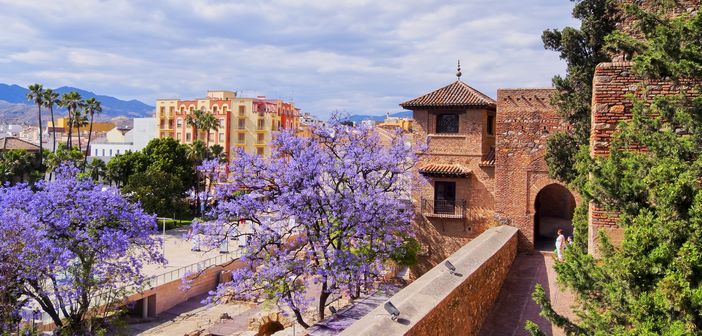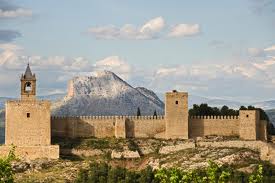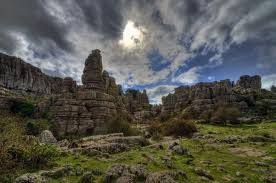Malaga

Thanks to its Moorish heritage, MALAGA, and in fact all of Andalucia, is full of fragrance, flowers & fruit from the scent of jasmine to vibrant hibiscus petals and the abundant almond, lime and olive trees. Situated right in the middle of the Costa del Sol Malaga city is ideally placed to welcome visitors and it still retains all the flavor of a traditional Spanish city.
MALAGA is the second largest city in Andalucia and enjoys a privileged situation with sandy beaches a mere stone’s throw away from the city’s commercial centre. Malaga has one of the largest Moorish fortresses in the area, the Alcazaba built between 8th and 11th centuries. The palace currently houses the archaeological museum and exhibits remains from the Phoenician and Roman periods. A circuit of walls connects the fortress with the Gibralfaro castle from where there are panoramic views of the city and coast. A partially excavated Roman amphitheatre is found at the entrance to the fortress.
A short distance away is the bullring and just a stroll takes you to the city’s beach, La Malagueta and the Paeso Maritimo. Here you will find restaurants that serve freshly-prepared pescaito frito (fried fish) or barbecued sardines, just two of the local specialties. Nearby is the cathedral which only has one finished tower and another half-finished and has been called La Manguita (the one-armed lady).
Malaga is known for its museums and art galleries and is the birthplace of the painter PABLO PICASSO. His house in Plaza de la Merced is a beautifully reformed 16th mansion and now is the site of the Picasso Foundation and has paintings, sculptures, drawings and ceramics donated by his family.
.jpg)
.jpg)
.jpg)
In contrast a vibrant Malaga can be found along the marble-paved Calle Marquis de Larios the main shopping street which joins Plaza de la Constitution, one of the city’s principal shopping boulevards. The whole area is full of fascinating back streets where specialist shops sell everything from candles to the latest fashions. In the centre of Malaga take a visit to the oldest bodega, Antigua Casa de la Guardia and try one of the many tapas and a glass of Malaga wine. You might even be lucky to see Malaga’s other famous son, the actor Antonio Banderas!!
Just outside the city are the San Jose and La Concepcion Gardens, linked in their origins in that they belonged to the same family, although nowadays the former can be visited by application only. La Concepcion Gardens were created by Jorge Loring Oyarzabal and Amalia Heredia Livermore more than 146 years ago. They traveled around France, Italy, Switzerland and Germany soon after their wedding and began to plant their own garden shortly afterwards. Imposing rubber plants, the grandiose araucarias and the lofty palm trees are 130-140 years old. Near the house is a date palm which was planted in 1859 and is tremendously high.
On the outskirts of the city you will find the Montes de Malaga nature park, a series of gentle hills which were reforested in the thirties in order to protect the city from floods caused by the Guadalmina River. It is possible to walk for miles deep into the park and at the very bottom is a hotel/restaurant where you can relax and enjoy typical Malaguenan food.
In the northern part of the province is the monumental town of ANTEQUERA in a flat agricultural area and stands in the shade of a Moorish church, the Nuestra Senora del Carmen, with its fine Baroque altar piece. ANTEQUERA is a town of enormous historic interest and wealth built through the centuries and kept in prime condition. The town’s monuments are present in the form of the Alcazar, the different gates of the Old Town wall and the religious constructions. There are around 30 churches and convents, and mansions with beautiful Andalucian patios, the most important being the Palace of Najera, nowadays converted into the municipal museum and which houses the first century bronze Roman statute of a young man known as “Efebo”.
A visit to Antequera would not be complete without seeing the famous Dolmens, ancient burial sites constructed 4,000 years ago by people of which very little is known. Try and figure out how the massive stone slabs could possibly have been transported from Cerro de la Cruz 1 kilometre away. See also the Roman and Arabic baths, and the Roman remains of the town of Singilia, and find time to visit the nuns at the Belen Convent and buy some of their delicious cakes.
Nature is represented by the Lover’s Rock, the symbol of eternal love, described in a legend which tells of the impossible love between a Christian man and Moorish girl who chose to throw themselves from the top of the rock rather than renounce their love and separate. Above all nature is present at the amazing beauty spot of El Torcal Natural Park where, over thousands of years, wind and rain has carved bizarre shapes. Visit the park at twilight and let your imagination run riot, but make sure you do not get caught in the dark!


.jpg)
South of ANTEQUERA is the quaint hamlet of VILLANUEVA DE CAUCHE located right on the Puerta Pedrizas high up where you can see beautiful landscapes. In the hamlet of narrow streets with their white house stands the small 17th century church where the villagers celebrate the May Crosses. Situated at the foot of the Sierra de las Cabrasa Mountains, VILLANUEVA DE CAUCHE was until a few years ago the last Spanish stronghold. The whole village was owned by the Marquesa de Cauche and owners of the houses built on her land around the palace paid an annual rent of one hen, or two if they had a patio. In 1989 the Marquesa agreed to sell out to the tenant farmers for a nominal sum.
In 1840 CASABERMEJA had brief notoriety when farmers ran the biggest landowners out of town and declared a repbulic. 40 horseman and 40 infantrymen were driven back when they were sent to crush the uprising. But a full scale army soon put paid to their republic.
Malaga’s very own LAKE DISTRICT is nestled between the mountains of La Huma and Las Sierra de Nieves. Only an hour inland the savage area is studded with high crags and soaring limestone cliffs. Its’ a place where you might glimpse the last species of wild goat in Europe foraging among the crisp-leaved green oaks, fragrant citrus trees and sweet smelling pine forests. This is an area of outstanding natural beauty. The lakes of the Guadalhorce reservoir when viewed from afar glitter like on fire and close up the artificial lakes boast a stunning diversity of wildlife, as well as a host of bars and restaurants. The three lakes were created in 1921 when a 200 m high dam was built across the Guadalhorce river gorge known as the Garganta del Chorro.
Carved out of the earth by the Guadalhorce River a 5 km-long 200 metre-deep Garganta del Chorro is alive with eagles, falcons and extreme sports enthusiasts who float and swoop and hang glide. It is also home to a film star, the sheer limestone cliffs that frame the backdrop for some of Sergio Leones’ spaghetti westerns. The Camino del Rey teeters across the gorge some 100 meters above the river. The walkway was built in 9121 as a walkway for the workers who were building the Conde del Guadalhorce reservoir, although its name comes from the visit made by King Alfonso XIII in 1921 for the inauguration of the reservoir. The bridge was where Frank Sinatra was shot and died while running back towards the train in the war movie “Von Ryan’s Express”. After considerable works the walkway is now open again to the public. The boardwalks and a hanging footbridge that stands at 105 metres height, as well as steep walls, make many visitors feel inevitably dizzy. The path is hazardous because of the heights and its very narrow parts. 2.9 km of their length between the entrance to them and the exit point comprise 1.5 km long boardwalks and 1.4 km long paths or forest walkways.
Heading back from the lakes stop at the Moorish ruins of BOBASTRO, built in the 10th century the once fortified village was the headquarters of Umar Ibn Hafsien, the man who lead the revolt against the CALIPH OF CORDOBA. Little remains of the ruined village accept the churches, monumental arches, but an intangible atmosphere still hangs over the deserted village, whilst the views over the olive groves and countryside are simply stunning. BOBASTRO is the same road that leads to the famous Caminito del Rey gorge-side walk way near El Chorro. However, just before a sharp bend on the MA05403, there is another, smaller road leading off, with a purple sign inviting you to visit Bobastro.
The jewel in Malaga’s crown must be RONDA, “City of Dreams", about 100 km from Malaga. Deep in the heart of the Serrania de Ronda, surrounded by lush river valleys and sitting above a deep ravine, it is literally a place that takes your breath away when seeing it. Ronda, beloved by author Ernest Hemingway and portrayed in his book “For Whom the Bell Tolls” is simply stunning. One day is not enough to see this beautiful town which has the oldest and most picturesque bullring in Spain and the best preserved Arabic baths. The BANDOLEROS MUSEUM, dedicated to the bandit, is colourful, full of history and well worth a visit.
Inside the gardens of the Casa del Rey Moro, there is an enigmatic passage that leads to the Guadalevín river through some two hundred steps that were excavated in one of the crevices of the Tajo de Ronda. According to legend, it was the Abomelic King who ordered the construction of this vertical tunnel or mine. The purpose of this was to allow his daughter to go down to bathe directly in the Guadalevín River. According to the data that have emerged to date, this underground passage dates from the last years of the ancient Al-Andalus, although the origin of its construction is not entirely clear. It could have been from a tunnel to allow the water supply from the river to a secret door to exit and enter the medina.
Syrian Prince Abu’l-Flda said Ronda "is an elegant and loft city in which the clouds serve as a turban and its towers as a sword belt". Irish novelist and poet JAMES JOYCE said "Ronda with the old windows of the houses, they eyes which spy out hidden behind the latticework, so that their lover might kiss the iron bar". And finally, Orson Welles said “A man does not belong to the place where he was born, but where he chooses to die” and what better place to choose than Ronda.
.jpg)
A 15-minute drive from Ronda takes you to the ancient city of ACINPO, where the Romans built another ancient settlement. The highest hill for miles around, it still has much evidence of their skills with a large part of its Amphitheatre intact and a lot more to look at, not to mention the stunning views.
High on a rocky saddle in the mountains east of Ronda, some 15km north of Ardales, the small town of TEBA possesses a rich medieval past, as demonstrated by ts castle which towers over the town, and its many majestic houses and small palaces. TEBA has one of the most extraordinary historical connections of any of Andalucía's pueblos. In 1330 Sir James Douglas was taking the heart of Robert the Bruce in a casket from his homeland in Scotalnd to the Holy Land when he became entangled with King Alfonso XI of Castile’s war with the Moors. In the ensuing SIEGE OF TEBA Sir James was killed when he defiantly hurled the casket containing the heart at the Moorish horsemen.
The Serrania de Ronda is rich in fauna and flora, the Spanish fir, the Pinsapo is found here. The scenery is stunning with picturesque white vilalges such as Ojen, Gaucin, Casares & Casarabonela to name a few. The Sierra de las Nieves is a biosphere with the undisputed king the wild goat. Mongoose, wild boar and wild cats are also found, and otters inhabit the rivers in this magnificent region.
Inland east of Malaga DAIMALOS is a very small village part of the Mudejar Route and just 14 km from the seaside resort of Torre del Mar. The easiest way to reach DAIMALOS is via ARENAS, keep going and round the next bend you will discover its cluster of white houses, apparently clinging together for fear of falling off the hill. Only around 100 people life in the village where life is tranquil and happy. Known for its oloroso wine, strangely the village doesn’t even have a bar!
DAIMALOS is probably most famous for its "FOUNTAIN OF LOVE". A small watering hole situated on the right as you drive up to the top of the village. FUENTE PERDIDA is an Arab fountain from the 12th century during the Marinid dynasty. The water from this fountain is supposed to be an aphrodisiac and legend has it that if a single person drinks from the fountain they will be married soon afterwards.
The fountain is mentioned in the DAIMALOS settlement books as early as 1561. Villagers believe that if you are already married drinking from the fountain will help you conceive and the flowing water is supposed to increase sexual power.
Take a look at some of the beautiful properties for sale in Malaga province. Maybe you are looking for a lovely country villa, a Bed & Breakfast property or property for horses, our selection has them all.
“Where that captivation, that yearning for a typical Andalucian city, of the people, that security for after, that stopped time? This is, here is Ronda, Serrania de Ronda, Ronda high and deep, round, profound, round and tall” Juan Ramón Jiménez (Nobel Prize in Literature, 1956).







